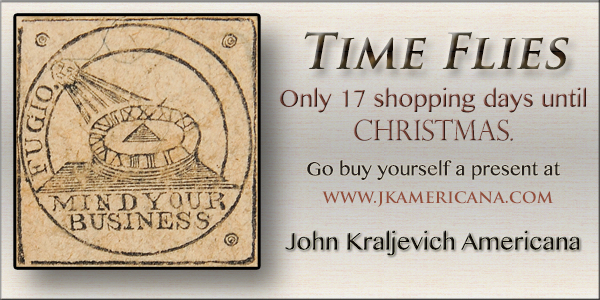
About UsThe Numismatic Bibliomania Society is a non-profit organization devoted to the study and enjoyment of numismatic literature. For more information please see our web site at coinbooks.org SubscriptionsThose wishing to become new E-Sylum subscribers (or wishing to Unsubscribe) can go to the following web page link MembershipThere is a membership application available on the web site Membership Application To join, print the application and return it with your check to the address printed on the application. Membership is only $20 to addresses in the U.S., $25 for First Class mail, and $30 elsewhere. For those without web access, write to: David M. Sundman, Treasurer
AsylumFor Asylum mailing address changes and other membership questions, contact David at this email address: dsundman@LittletonCoin.com SubmissionsTo submit items for publication in The E-Sylum, just Reply to this message, or write to the Editor at this address: whomren@gmail.com BUY THE BOOK BEFORE THE COINSale Calendar |
- WAYNE'S WORDS: THE E-SYLUM JUNE 28, 2015
- ASYLUM JANUARY-MARCH 2015 ISSUE PUBLISHED
- AUCTIONES DUPLICATES OF THE BCD LIBRARY – PART 2
- HARDCOVER NEWMAN SALE VI AVAILABLE
- NEW BOOK: 100 GREATEST WOMEN ON COINS
- NEW BOOK: MEDALLIC ART OF THE ANS
- BOOK REVIEW: MEXICAN BEAUTY: UN PESO CABALLITO
- BACKSTORY: TALES FROM THE BOURSE
- NOTES FROM E-SYLUM READERS: JUNE 28, 2015
- ANNOTATED WEBER AND DE SARTIGES CATALOGUES SOUGHT
- MORE SELECTIONS FROM NUMISMATIC AUCTIONS SALE #57
- THE WILLIAM HENRY HARRISON CONGRESSIONAL GOLD MEDAL
- VIDEO: MEDICAL AND SCIENTIFIC MEDALS AT FALK LIBRARY
- MORE ON CIVIL WAR OVERPRINTED SCRIP NOTES
- MORE ON THE 1973 SERIES A AND B COINS OF GREECE
- MCA ADVISORY 2015 NO. 1 PUBLISHED
- ERRORS ON MEDALS
- WORKING WITH FREY'S DICTIONARY OF NUMISMATIC NAMES
- ARTICLE PROFILES PARKWAY QUARTER DESIGNER FRANK MORRIS
- THE BLUE RIDGE QUARTER LAUNCH CEREMONY
- QUICK QUIZ: WHAT DO THESE PHOTOS HAVE IN COMMON?
- THE 'KEEP HAMILTON' MOVEMENT GAINS STEAM
- NUMISMATOURIST HOWARD BERLIN VISITS MADRID
- MEDALLIC REMEMBRANCES OF LONDON BRIDGE
- IMAGES SURFACE OF PURPORTED ISIS COINS
Click here to access the complete archive
To comment or submit articles, reply to whomren@gmail.com
WAYNE'S WORDS: THE E-SYLUM JUNE 28, 2015

We have no new subscribers this week, and have a total subscriber count of 1,847.
Your Editor is on the road for a family vacation. As a result this issue is shorter than usual and the next issue may come late or not at all. My apologies to those who sent submissions that didn't make it in this week. But keep your emails coming in the meantime, and thanks for your patience.
This week we open with word on the latest Asylum issue, a numismatic literature sale, the latest Newman hardbound catalog, two new books and one review.
Other topics include the Feigenbaum book Tales From the Bourse, an important early Congressional Gold medal, the Falk Library medical medal collection, overprinted scrip notes, errors on medals, and numismatic remembrances of the London Bridge.
To learn more about the BCD Library, the 100 greatest women on coins, medallic art of the ANS, Haiti Pattern coinage, the Blue Ridge Parkway quarter, Real Casa de Moneda, and those purported "ISIS" coins, read on. Have a great week, everyone!
Wayne Homren
Editor, The E-Sylum
ASYLUM JANUARY-MARCH 2015 ISSUE PUBLISHED
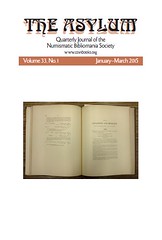 Another
issue of The Asylum is at the printers. Here are the contents:
Another
issue of The Asylum is at the printers. Here are the contents:
- Marc Ricard, President’s Message
- Margo Russell, A Bibliophilic Tribute to Margo Russell in Her Own Words, with an Introduction by George Kolbe
- George Kolbe, Large-Paper Attinelli Sighting in Boston
- David F. Fanning (with additional material by Q. David Bowers), Off the Shelf: The Empire Coin Company
For a membership application form, see:
www.coinbooks.org/about/NBS_Membership_Form_2014.pdf
AUCTIONES DUPLICATES OF THE BCD LIBRARY – PART 2
Björn Schöpe of CoinsWeekly writes:
Coin collectors who look for important numismatic books can rejoice: The young Swiss company Auctiones will offer duplicates from the legendary numismatic BCD library in their upcoming eAuction 39. These roughly 238 lots can be viewed on the internet as of 22 June, 2015. The actual electronic auction will start on 5 July at 7 p.m. sharp.
5 July, 2015
Auctiones GmbH
eAuction 39
Duplicates of the BCD Library – Part 2
It was a nice, time-honored tradition for world-class collections to offload their duplicates in an auction from time to time. We know of auctions with duplicates from the Royal Coin Cabinet at Berlin, with duplicates from the Coin Collections of the All-Highest Imperial House, also known as Coin Cabinet Vienna, and of the British Museum. Duplicates were sold by the Boston Museum, by Dumbarton Oaks, or the Hermitage. Even though the last-mentioned did it in order to acquire foreign currency for the Communist government, the selling of duplicates used to be a recognized means to create space in the collection and, at the same time, to generate the financial means needed for new acquisitions. The collectors rejoiced and willingly spent their money in such auctions, because owning an item that used to be a part of a renowned collection was and still is a special feeling.
That is why many bibliophilic coin collectors will be delighted to hear that the collector BCD has checked his huge library for duplicates once again. His initials are known to all those who love Greek coins, with the BCD Collection comprising Greek mainland coins having been sold in several comprehensive auction catalogs. Less known is the fact that BCD has assembled a library on Greek numismatics that is by far the largest and most comprehensive of its kind in private hands. Unsurprisingly, therefore, his duplicates include a couple of little gems. This offer of extremely rare, highly specialized books is something very special.
Responsible is the young Swiss company Auctiones that will auction the roughly 238 lots in their upcoming eAuction 39. These lots can be viewed on the internet as of 22 June, 2015, at www.auctiones.ch. The actual electronic auction will start on 5 July at 7 p.m. sharp.
As always, the books’ provenance and the languages in which they come are a pleasure in themselves. English, French and German are more or less standard today. They are complemented by Bulgarian, Catalan, Danish, Dutch, Finish, Greek, Hungarian, Italian, and Turkish. The spectrum ranges from general publications (lot 1-34), Greek coins (35-56), Roman coins with provincial issues (57-127), Byzantium, Early medieval and crusaders (128-135), offprints (136-174) and auction catalogs (175-238). The estimates are quite modest. For some of the lots bidding begins with 5 CHF, nevertheless, no experienced book lover will seriously expect to get his “favorite” for as low a price.
What makes the manuscript on the BCD Library duplicates so special are the many notes that reveal the profound knowledge and the great care with which the collector has examined his books. Almost every lot has a personal note of the owner to provide the potential bidder with a hint whether or not he really needs this book.
These notes have been written with much humor. BCD comments on a Sotheby catalog from 10 November, 1972, for instance: “The auction that signaled the beginning of the price rally that finally placed ancient coins in the category where they should always belong: small in size but great in value.”
Singling out individual books in this text would be pointless for the collector finds that book the most interesting that deals with his very field of expertise. This is the category in which the duplicates of the BCD Collection have incredibly much to offer.
All those who have become curious can find the lots on the internet as of 22 June, 2015. Further details and the possibility to view the books are provided by Auctiones GmbH, P.O. Box 673, 3000 Bern 8, Switzerland; phone +41313113948, e-mail: info@auctiones.ch
You will find the auction sale at http://www.auctiones.ch/
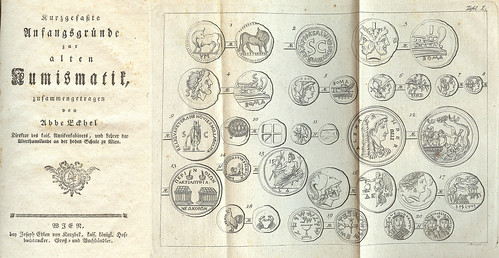
11. Eckhel, Abbe [Joseph]. Kurzgefasste Anfangsgründe zur alten Numismatik. Vienna, no date (1788). 8vo, Hardcover, blue boards, spine label with gilt letters; 133 pages, 6 engraved plates. Ex-library, covers worn, interior Good. Lipsius p. 110. Estimate: 50,- CHF.
A note from BCD: Rare and in great demand; the 6 folding plates provide us with admirably faithful etchings of Greek and (mostly) Roman coins.
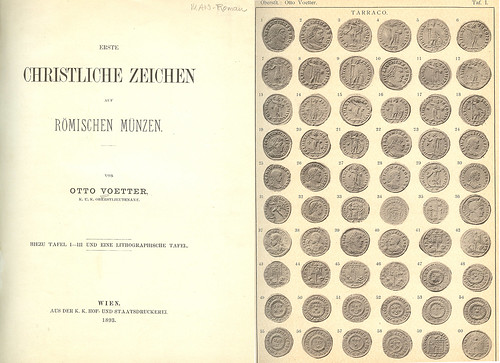
121. Voetter, Otto. Erste christliche Zeichen auf römischen Münzen. Wien 1893. 8vo, recently bound in quarter orange leather, matching linen, brown spine letters; 38 pages, 3 plates, foldout tables of coin inscriptions. Interior Very Good. Estimate: 20.- CHF.
A note from BCD: With many pages of thin card stock bound at the end so that additional photographs and text may be glued on. A scarce and nicely bound publication.
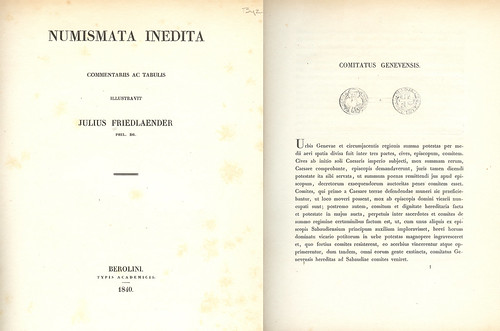
131. Friedlaender, Julius. Numismata Inedita. Commentariis ac Tabulis. Berlin 1840. 4to, brown boards stained and bumped; 50 pages. Some foxing to end papers and title. Pencil title/date on cover. Fair. Lipsius Suppl. p. 45. Estimate: 50,- CHF.
A note from BCD: One of Friedlaender’s rarest works. I have never seen another offered for sale. Excellent and very precise and accurate engravings. A valuable antiquarian book.
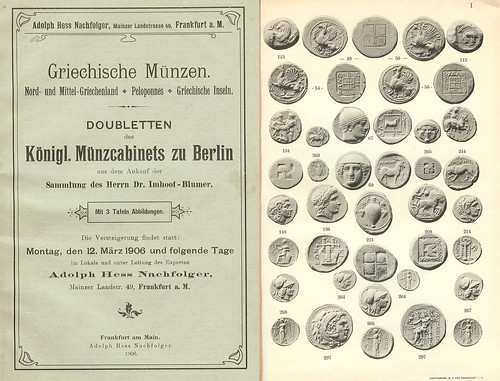
196. [Berlin/Imhoof-Blumer] Hess, Adolph. Frankfurt, 12 March 1906. Doubletten des Königl. Münzcabinets zu Berlin aus dem Ankauf der Sammlung des Herrn Dr. Imhoof-Blumer. Griechische Münzen, Nord- und Mittel-Griechenland, Peloponnes, Griechische Inseln. 1169 lots, 58 pages, 3 plates; original paper covers worn and chipped with corner piece missing from back cover without loss of text, excellent plates, interior Very Good. Spring 314. Estimate: 15.- CHF.
A note from BCD: The Mainland Greece duplicates of Berlin give a very good idea of the collection’s magnificence. Rare and important.
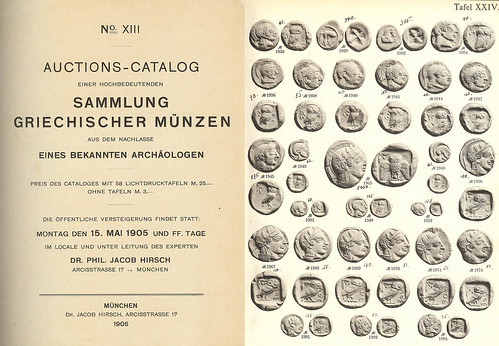
221. [Rhousopoulos] Hirsch, Jacob. Munich, XIII. 15 May 1905. Sammlung griechischer Münzen aus dem Nachlasse eines bekannten Archäologen. 4627 lots, 292 pages, 58 plates; recent beige linen with leather spine labels; original card covers and photocopy of prices realized list bound in. Some neat inked prices in text margins and on plates. Very Good. CS 1941, 1979; Kroh p. 34; Spring 371. Estimate: 150,- CHF.
A note from BCD: The catalogue of a great collection, always in demand. My copy was often at my bedside and I never tired of admiring its rarities before going to sleep.
TOKEN, MEDAL AND POLITICAL AUCTION
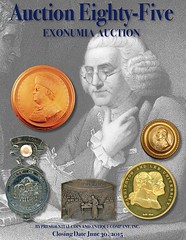
Presidential Coin & Antique Co., Inc.'s Auction Eighty-Five of Tokens, Medals and Political items closes June 30, 2015. Hardcopies $6 - contact Joe Levine at Jlevine968@aol.com or view the catalog online here .
Hard Times Tokens, 19th Century Storecard Tokens, Civil War Tokens, Military & Related, So-Called Dollars, Presidential & Political, World's Fairs & Expositions, U.S. Mint Medals, ANS Medals, Foreign Tokens and Medals, and MORE!
HARDCOVER NEWMAN SALE VI AVAILABLE
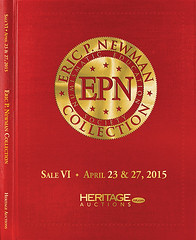 Kolbe & Fanning have released the sixth volume of the special hardcover edition of the Eric P. Newman collection series. Sale VI (held
April 23 & 27, 2015 by Heritage Auctions) focused on selections from Newman's legendary collection of paper money. The stand-alone
catalogue can be ordered from Kolbe & Fanning at www.numislit.com. Subscriptions for the entire series, including those already issued, can
still be placed as well.
Kolbe & Fanning have released the sixth volume of the special hardcover edition of the Eric P. Newman collection series. Sale VI (held
April 23 & 27, 2015 by Heritage Auctions) focused on selections from Newman's legendary collection of paper money. The stand-alone
catalogue can be ordered from Kolbe & Fanning at www.numislit.com. Subscriptions for the entire series, including those already issued, can
still be placed as well.
The special hardcover edition series is being produced by Kolbe & Fanning by arrangement with the Eric P. Newman Numismatic Education Society, which will receive $25 from the sale of every catalogue to further its philanthropic activities, including the advancement of numismatic scholarship.
The Eric P. Newman Numismatic Education Society will receive $25 from the sale of every catalogue to further its philanthropic activities, including the advancement of numismatic scholarship. - See more at: http://www.numislit.com/pages/books/2425/eric-p-newman-collection-special-hardcover-edition-sale-i-single-copy-of-sale-i-pattern-coins#sthash.aEobZ3aO.dpuf
NEW BOOK: 100 GREATEST WOMEN ON COINS
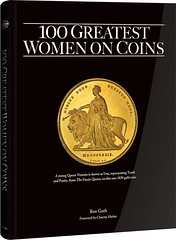 With the U.S. Treasury getting ready to feature a woman on the new $10 bill, the subject of
women on money is more relevant today than ever before. To celebrate this, Whitman Publishing announces the release of a beautifully
illustrated new coffee-table book, 100 Greatest Women on Coins. Ron Guth, one of America’s most popular authorities on money, takes
the reader on a personal guided tour of coins from ancient Greece to our modern-day pocket change.
With the U.S. Treasury getting ready to feature a woman on the new $10 bill, the subject of
women on money is more relevant today than ever before. To celebrate this, Whitman Publishing announces the release of a beautifully
illustrated new coffee-table book, 100 Greatest Women on Coins. Ron Guth, one of America’s most popular authorities on money, takes
the reader on a personal guided tour of coins from ancient Greece to our modern-day pocket change.
“America’s currency is a way for our nation to make a statement about who we are and what we stand for,” Treasury Secretary Jacob J. Lew said on June 17, 2015. “The images of great American leaders and symbols they depict have long been a way for us to honor our past and express our values.” This has been true about images on coins worldwide for thousands of years.
The 100 Greatest Women on Coins include real women such as Cleopatra, Martha Washington, and Mother Teresa; goddesses such as Athena, Demeter, and Nike; allegorical women (who represent an idea or nationality) such as Miss Liberty, Mother Earth, and Britannia; and women in art, such as La Pietà and Auguste Renoir’s Girls at the Piano.
“100 Greatest Women on Coins is a celebration of the hundreds of women who have appeared on coins from ancient times to the present,” says author Ron Guth. “This is a book about mothers, daughters, sisters, wives, empresses, queens, ballerinas, athletes, goddesses, regents, allegorical figures, and the many forms in which women have appeared on coins. It’s the story of women who have made important contributions to history, politics, the arts, the sciences, and myriad other fields.”
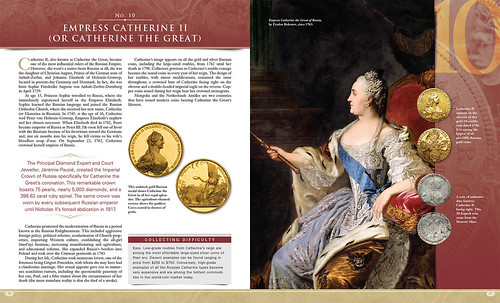
The 100 Greatest were ranked and voted into place by members of Women in Numismatics, a national hobby organization of collectors, dealers, researchers, and historians. The coins on which the 100 Greatest Women appear include valuable gold and silver pieces, unusual commemoratives, and super-rarities, as well as more common pieces that you can find in your pocket change.
The book includes a foreword by Charmy Harker, president of Women in Numismatics and a noted coin dealer, who calls it “a fascinating look into the important role women have played throughout numismatic history and throughout history in general.”
“100 Greatest Women on Coins is not just a price guide or a fancy picture book,” says Whitman Publishing president Mary Burleson. “It’s a time machine that takes the reader to a hundred different points in world history. And it’s a fascinating and colorful introduction to the hobby of collecting coins.”
The book is coffee-table size, 128 pages, full color, with photographs and stories for every coin. It also includes market values and tips on building an impressive coin collection. Retail price is $29.95. 100 Greatest Women on Coins will be available in September 2015, online and at hobby shops and bookstores nationwide. It can be pre-ordered online, including at www.Whitman.com.
# # #
100 Greatest Women on Coins
By Ron Guth; foreword by Charmy Harker
ISBN 0794843360
Hardcover, coffee-table size (10 x 12 inches)
128 pages
Full color
Retail $29.95 U.S. Online at
www.whitman.com/store/Inventory/Detail/100-Greatest-Women-on-Coins+0794843360
NEW BOOK: MEDALLIC ART OF THE ANS
The American Numismatic Society (ANS) is proud to now offer a new and much anticipated publication for sale, Medallic Art of the American Numismatic Society, 1865-2014, Studies in Medallic Art 2. The hardcover book, by Scott H. Miller, includes 60 medals issued by the ANS, two COAC medals and the 1910 Actors’ Fund Medal, all accompanied by color photographs.
Many of the entries are supplemented with artist sketches, archival photographs, and corresponding stories. Also included are four appendixes, which note recipients of some of the medals and contains a list of dies, hubs, galvanos and casts of ANS medals in the ANS’s own collection.
Commenting on the new book, Andrew Reinhard, Director of Publications, said “The ANS has been a leader in the publication of art medals in the U.S. for the past 150 years. The issuance of medals has been at the forefront of the ANS mission since its inception, as they are as important as coinage in terms of history and beauty. Working with Scott Miller to produce the book was a rewarding experience, and we are all very happy that it is now available to the public.”
Medallic Art of the American Numismatic Society, 1865-2014, is available for purchase on the ANS website, http://numismatics.org/Store/ANSMedals, or by calling Catherine DiTuri at 212-571-4470, ext. 117. List price is $100; ANS member may purchase it for $70.
For more information, or to order, see:
The American Numismatic Society Publishes Medallic Art of the ANS
(numismatics.org/NewsEvents/MedallicArtBook)
BOOK REVIEW: MEXICAN BEAUTY: UN PESO CABALLITO
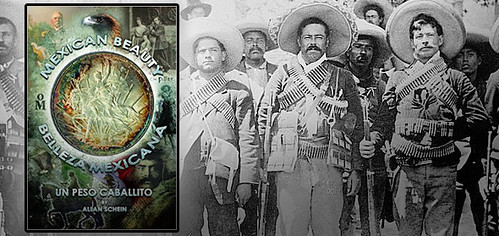
Schein makes no bones about it: the Caballito is by far his favorite coin. The design was born in Beaux-Arts-era France, surreptitiously “improved-upon” by U.S. Mint Chief Engraver Charles Barber, and struck during five of the most turbulent years in modern Mexican history – years that saw the overthrow of Mexican President Porfirio Díaz, a descent into revolutionary chaos, the assassination of Díaz’s rival and successor Francisco Madero and the infamous rise of El Chacal, Victoriano Huerta.
How does the Chinese curse go, “may you live in interesting times”?
The coin itself was adapted from a 50-Centavo pattern from 1907 designed on commission by French engraver Charles Pillet (1869-1960). It’s a striking design, evoking the spirit of national independence. The reverse (often confused for the obverse) features a partially-clothed female riding side-saddle (for the sake of modesty, we presume) atop a majestic horse, its hooves unshod, its disposition wild and bucking. In the figure’s right hand, according to Schein, is a forked branch from an Encino Oak. In her left hand a torch, held high. Behind the horse and its rider are the beaming rays of the sun (something French commander Charles de Lorencez probably wishes he saw more of before facing Ignacio Zaragoza at Puebla).
The obverse provokes discussion as well. A proud eagle sits atop a cactus, atop an earthen mound, a snake in the grip of its beak and talon. For generations, Schein says, numismatists have argued about the identity of the bird. Some suggest the bird is a Caracara – a slow-flying scavenger. For Schein, there’s little doubt that the bird is in fact a Golden Eagle. Readers of the book will enjoy the lengths that Schein goes to in order to buttress his position. One doesn’t need to be an ornithologist, however, to appreciate the sculptural beauty of the design.
Fans of the Beaux-Arts style of design and architecture will enjoy seeing the Cabalitto in the context of its designer’s larger body of work. The book is as much a “first course” in the study of the Mexican one-peso coin of 1910-1914 as it is a primer in the work of the man whose hands and chisel created it.
It’s a solid and worthwhile effort on a worthy topic, written in English with a side-by-side Spanish translation provided by Roberto del Bosque, a coin dealer from the firm Mexican Coins and More of Brownsville, Texas.
For a self-published work, interested readers will find no fault in the quality of the presentation. Coin photographs are clear and in full-color. Archival photographs of important historical figures and other key works of the engraver are presented, and sections devoted to variety attribution and grading effectively convey the intended information.
Mexican Beauty: Un Peso Caballito
Allan Schein
239 pp. Self Published. Price: $40 (2014)
To read the complete article, see:
First Read: Mexican Beauty: Un Peso
Caballito (www.coinweek.com/expert-columns/first-read-mexican-beauty-un-peso-caballito/)
BACKSTORY: TALES FROM THE BOURSE
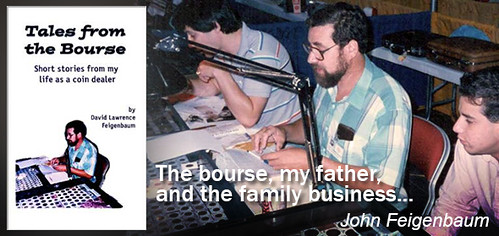
With his trusty young son (me) at his side, Dave had already been building a small part-time coin business.
We traveled extensively to regional coin shows on the weekends and started a fledgling mail order operation out of the spare bedroom in the house.
To be honest, it was really quite fun and afforded me lots of opportunities to learn the basics of small business operations. I learned basic business skills like managing expenses, balancing a checkbook, insurance, customer relationships, and so on. My father and I loved this little business more than anyone could imagine.
Originally, we published multi-page price lists of thousands of circulated Barber coins graded from AG to AU, with an average price of about $25.
In the days after the price list was mailed out the orders would come in and we’d delight in every single sale. Daily trips to the post office to look for orders were the highlights of many days.
I recall, for example, a customer that came out of the blue with an order for over 50 individual coins. The total for the order was around $750, but my father was so excited you would’ve thought he’d won the lottery.
A single order like that gave him the motivation to take the business to the next level, and he was the happiest person in the world to be able to turn a life-long hobby into a career.
Sadly, that career was cut short.
In 1996 as the company was growing, Dave’s body was breaking down. I probably don’t have to tell you how terrible ALS is. But seeing it rob my father of the use of his limbs and throat muscles first-hand is something that no words can adequately describe.
My father was brave and undeterred through his horrible “journey” and he adapted to any technology then available to help him cope with the hours of boredom stuck in a useless body.
He eventually lost all use of his arms and legs, so he discovered an eye-gaze device which allowed him to type with eyeball movements, focusing on specific letters on a screen. The time required to write a single word was excruciating but it kept him busy and mentally active.
During the time between 1998 until he passed in 2002, Dave wrote two books entirely with the eye-gaze system. The first, entitled Journeys with ALS, was a compilation of short stories of other ALS victims and the story behind the disease’s effect on the patient and family members.
The second book was Tales from the Bourse: Short Stories from my Life as a Coin Dealer, which he eye-penned in 2001.
The book recounts 19 different vignettes of events that stuck in his mind from thousands of interactions he’d had during his career as a part- and full-time coin dealer.
Some are funny, others are strange and all are personal for me because I bore personal witness to most of them.
Acting as his publisher/editor, I recall cringing while I worked on the final edition. With all respect for a man in his physical state at the time (paralyzed, weak and literally speechless) I came to him with the draft under my arm and tried to break the news to him gently.
I said something like Dad, nobody will read this book. The stories really aren’t that interesting. But he looked at me with the wry, contorted smile that is all an ALS victim can manage and told me in a single glance, “Son, you’re wrong. People will read this book, and… even if they don’t, you’d better publish it anyway.”
How could I say no?
The initial printing of the book was 1,000 copies, a full run for numismatic non-fiction.
The response to the book was beyond our wildest expectations.
We sold out the first printing in 6 months. The outpouring of responses from readers was unlike any other book he’d ever written.
The stories strike a nerve with collectors, dealers and non-coin people, because they provide a slice of life into a world that is foreign to most of us.
To read the complete article, see:
The Story of Tales from the Bourse
(www.coinweek.com/coins/coin-supplies/books-2/story-tales-bourse/)
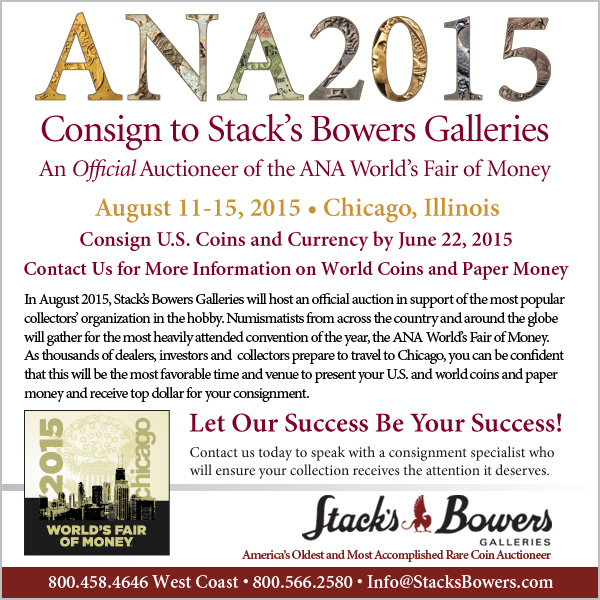
NOTES FROM E-SYLUM READERS: JUNE 28, 2015
On the British Museum Continental Dollar
Tom DeLorey writes:
Another great issue! That Continental dollar is amazing!
To read the earlier E-Sylum article, see:
NOTES FROM E-SYLUM READERS: JUNE 21, 2015 : British Museum Continental Dollar
(www.coinbooks.org/esylum_v18n25a09.html)
Researching the Castorland Jeton
Chester Sullivan writes:
Let me tell you how excited I was to learn, via The E-Sylum, about the French language Association des Collectioneurs de Jetons-Monnaie. I'm researching the Castorland jeton question from both the French and American (Canadian of course) sides of the Atlantic. The E-Sylum came through yet once again!
To read the earlier E-Sylum article, see:
FEATURED WEB SITE: FRENCH TOKEN COLLECTORS ASSOCIATION
(www.coinbooks.org/esylum_v18n25a33.html)
The Three Garridebs Counterfeit Notes
Ron Haller-Williams writes:
I'm surprised that Greg Ruby is requesting images of five-pound notes!!! In those days higher-value notes were also fairly common, and the story The Adventure of The Three Garridebs deals NOT "with a printing press and counterfeit 5 pound notes" but with a printing press and counterfeit 100 pound notes! I quote from the story: “The greatest counterfeiter London ever saw. That’s Prescott’s machine, and those bundles on the table are two thousand of Prescott’s notes worth a hundred each and fit to pass anywhere. Help yourselves, gentlemen. Call it a deal and let me beat it.”
Here's a 1936 specimen:
www.britishnotes.co.uk/news_and_info/picture_library/
englishpictures/whitenotes/peppiatt.php
www.britishnotes.co.uk/news_and_info/picture_library/
englishpictures/whitenotes/peppiatt_£100_liverpool_.jpg
1914:
www.britishnotes.co.uk/news_and_info/picture_library/
englishpictures/whitenotes/nairne.php
www.britishnotes.co.uk/news_and_info/picture_library/
englishpictures/whitenotes/b208fh_100_manchester_1914__7_y.jpg
To read the earlier E-Sylum article, see:
1890'S BANK OF ENGLAND FIVE POUND BANKNOTE IMAGES SOUGHT
(www.coinbooks.org/esylum_v18n25a20.html)
Numismatics in The Picture of Dorian Gray?
Larry Dziubek writes:
I was watching the 1945 movie The Picture of Dorian Gray and there is a scene about an hour and 15 minutes into it where Dorian goes to a wall cupboard and brings a small stack of boards to a table. While talking to another man in the room he begins to study some coins in the classic way, looking through a glass and placing them in a tray with circular holes. Not a single word was said regarding coins or what he was handling. It did not play any real part of the story. Curious distraction?
Colorado's Champion: Rocky Mountain News Token
David Pickup writes:
Here are some photos of a medallion I got yesterday. It is inscribed:
BOAST FOR – DENVER- AND THE – ROCKY MOUNTAIN-
NEWS- THE RECOGNIZED-WANT AD MEDIUM- OF THE WEST
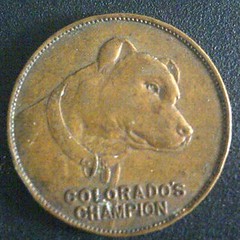
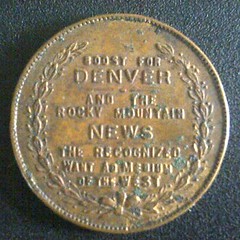
ANNOTATED WEBER AND DE SARTIGES CATALOGUES SOUGHT
Hadrien Rambach writes:
Esteemed colleagues, I was wondering if anyone among you would have annotated copies (with realized prices and buyers names) of the following two Roman coins auction-catalogues, as I am trying to trace the provenance of a rare aureus for an article. Many thanks in advance!
* Collection of consul Eduard Friedrich Weber (1830-1907); sold: Jacob Hirsch (Munich), auction XXIV, 10 May 1909, lot 2252
* Collection of viscount Louis de Sartiges (1859-1924); sold: J. Hirsch & L. Naville – Ars Classica (Lucern), auction XVIII, 10 October 1938, lot 425
THE BOOK BAZARRE
MORE SELECTIONS FROM NUMISMATIC AUCTIONS SALE #57
Lot 1394: Haiti Pattern Coinage Centime, 1807
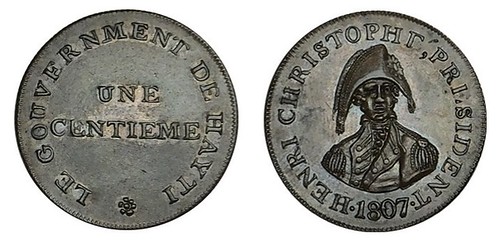
Haiti Pattern Coinage Centime, 1807. Diagonal milling. KM-Pn1, Fonr. 7483. EF-AU or slightly better. Very scarce. ($400-600)
Lot 1484: Norway Specie Daler, 1835
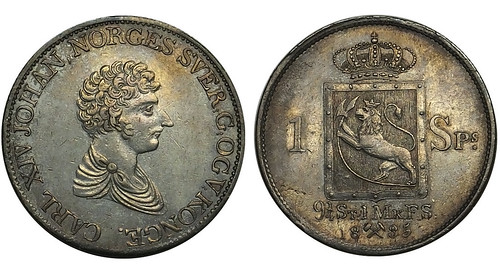
Norway Specie Daler, 1835, no star. KM-301. EF/Choice EF, pastel blue and amber toning over faint trace hairlines. ($600-800)
Lot 1497: Paraguay Pattern 10 Pesos, 1864.
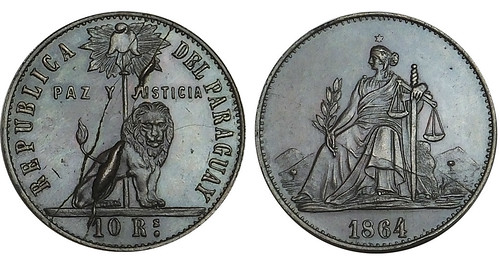
Paraguay Pattern 10 Pesos, 1864. Bronze, plain edge. KM-unlisted, designs as KM-Pn11 to Pn13. Choice EF-AU, unusual die state exhibiting near terminal failure. Interesting and very rare example for the specialist. ($1000-1500)
Lot 1672: Great Britain. Token. Berkshire, Reading. 18 Pence, 1811

Great Britain. Berkshire, Reading. 18 Pence, 1811. Silver. D-4. Handsome ltly toned Prooflike Unc. Very scarce I.B. Monck, Esq. issue in this grade. ($200-300)
For more information, see:
www.numismaticauctionsllc.com
To read the earlier E-Sylum articles, see:
NUMISMATIC AUCTIONS SALE #57 CLOSES JUNE 29, 2015
(www.coinbooks.org/esylum_v18n22a14.html)
SELECTIONS FROM NUMISMATIC AUCTIONS SALE 57
(www.coinbooks.org/esylum_v18n23a20.html)
MORE SELECTIONS FROM NUMISMATIC AUCTIONS SALE #57
(www.coinbooks.org/esylum_v18n25a14.html)
THE WILLIAM HENRY HARRISON CONGRESSIONAL GOLD MEDAL
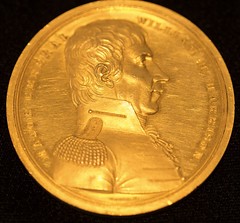 The Raab Collection, the nation’s leading dealer in important historical documents, announced today
that it is offering for sale a great American treasure, whose survival had been unknown to the public or historical community: the original
Congressional Gold Medal from the early years of the United States, given to victorious General and future President William Henry Harrison
for saving the American West in the War of 1812. This medal, which had been retained by descendants until this summer, is one of only a
handful known to have survived the centuries and the only from the era given to a President now in private hands. It has never been offered
for sale before and is valued at $225,000.
The Raab Collection, the nation’s leading dealer in important historical documents, announced today
that it is offering for sale a great American treasure, whose survival had been unknown to the public or historical community: the original
Congressional Gold Medal from the early years of the United States, given to victorious General and future President William Henry Harrison
for saving the American West in the War of 1812. This medal, which had been retained by descendants until this summer, is one of only a
handful known to have survived the centuries and the only from the era given to a President now in private hands. It has never been offered
for sale before and is valued at $225,000.
“It is an honor to handle such a historic treasure and remarkable that it survived the ages,” said Nathan Raab, President of The Raab Collection. “It represents a great moment in American history that led to the ascension of an American President. It is a truly unique artifact.”
Since the American Revolution, Congress has reserved its highest expression of national appreciation for the Congressional Gold Medal. The tradition began when General George Washington received it in 1776 from the Continental Congress. This tradition, giving the nation’s honor as a Congressional Gold Medal, continued under the Constitution, but with only some 30 people receiving them in the early (pre-1840) period.
Of the 30 or so Congressional Gold Medals from the War of 1812 and earlier, fewer than half are known definitively to have survived. There is only one other during this early period known to be in private hands and it was given to a Commodore, not a President. The rest are in institutions. Only three medals have come to market in the past few decades, the most recent approximately 10 years ago.
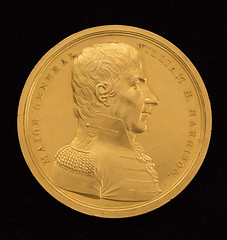
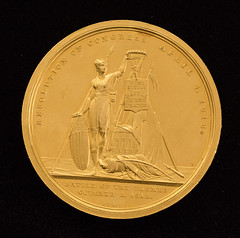
William Henry Harrison received this medal for his great victory at the Battle of the Thames during the War of 1812, in which he guaranteed American possession of the Northwest. It was awarded by an act of Congress approved in 1818, when he and his men were honored “for their gallantry and good conduct in defeating the combined British and Indian forces...."
The engraver is Moritz Furtz and the designer of the obverse is Thomas Sully. The medal is forged in gold. It is large, weighing more than 300 grams and measuring 2.5 inches in diameter. It retains the original presentation case. There was a special ceremony to formally present Harrison with his medal, and it was presided over and bestowed on him by the President of the United States, James Monroe.
Provenance: The original gold medal presented to Harrison, the location of which has been unknown to the public, was a treasure passed down in the Harrison family. We acquired it from an heir directly and offer it here for sale for the first time. (below: the medal with the original case as given to Harrison)
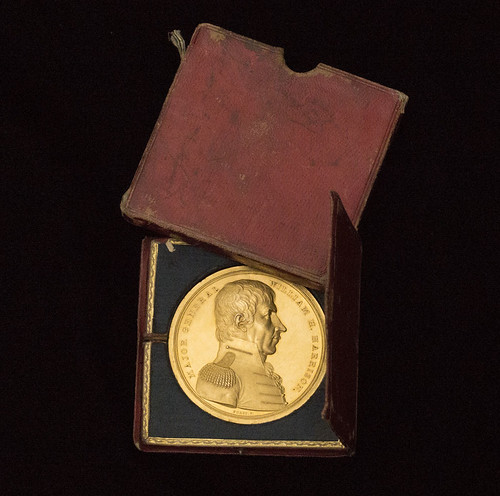
About The Raab Collection: The Raab Collection has handled many of the most important historical documents to reach the market and worked with the families of famous Americans in the sale and preservation of their family treasures, among them Thomas Jefferson, Ulysses S. Grant, Ronald Reagan, and F. Scott Fitzgerald. Nathan Raab, a member of the Board of Directors of the Historical Society of Pennsylvania, is also a contributor to Forbes.com.
For more information, see:
The Unveiling of the Harrison Congressional Gold
Medal (www.raabcollection.com/blog/unveiling-harrison-congressional-gold-medal)
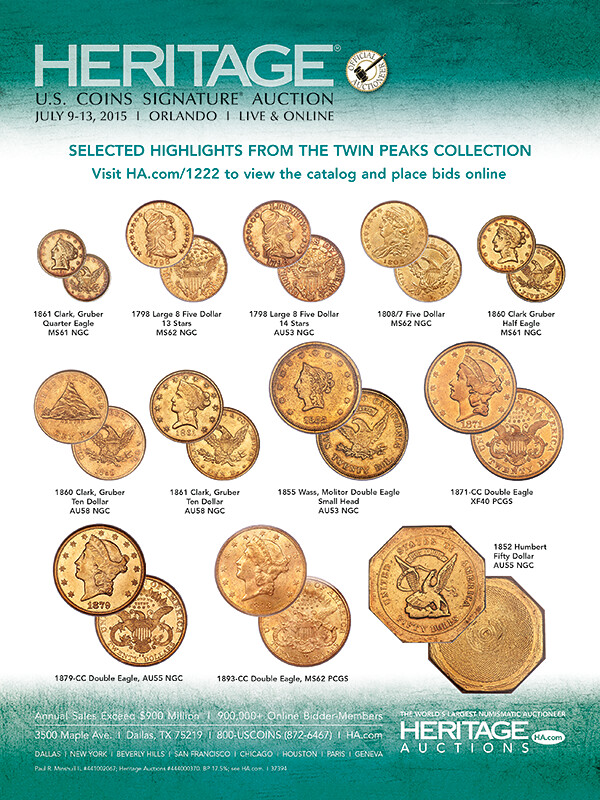
VIDEO: MEDICAL AND SCIENTIFIC MEDALS AT FALK LIBRARY
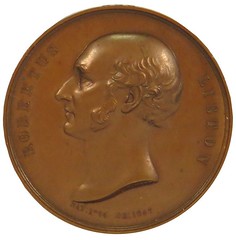 Gosia Fort
has been keeping E-Sylum readers informant about the Medical and Scientific medals collection at the Falk Library, part of the
Health Sciences Library System at the University of Pittsburgh, where Gosia is Head of Digital Resource Development. The library has just
released an excellent new video highlighting the collection. Here are a few screen captures, but be sure to watch the view peruse the
online collection catalog. Very nicely done! -Editor
Gosia Fort
has been keeping E-Sylum readers informant about the Medical and Scientific medals collection at the Falk Library, part of the
Health Sciences Library System at the University of Pittsburgh, where Gosia is Head of Digital Resource Development. The library has just
released an excellent new video highlighting the collection. Here are a few screen captures, but be sure to watch the view peruse the
online collection catalog. Very nicely done! -Editor
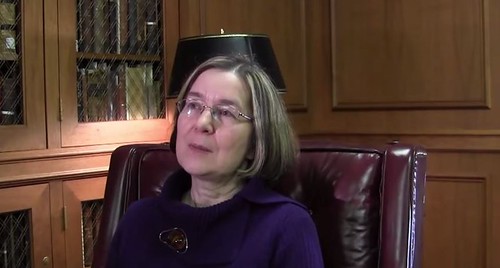
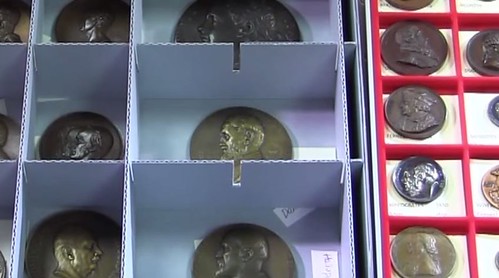
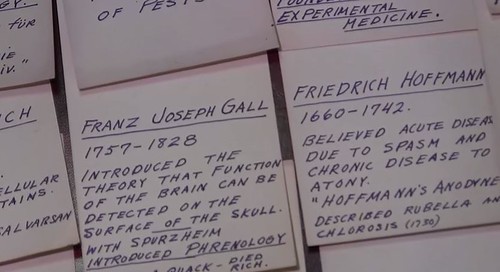
To view the video, see:
Medical and Scientific Medals of Falk Library's Historical Collection
(www.youtube.com/watch?v=Oa82AyrVvLw)
To view the exhibit online, see:
www.hsls.pitt.edu/about/rarebook/medals
Gosia adds:
If you cannot get rotation of the medal, reload the page.
To view the medal collection online, see:
Medical and Scientific Medals at Falk Library
(http://hsls.pitt.edu/about/rarebook/medals)
THE BOOK BAZARRE
MORE ON CIVIL WAR OVERPRINTED SCRIP NOTES
Ron Ward writes:
Due to the complete absence of metal for minting coins and tokens in the South during the Civil War, millions of small change notes, most commonly 10, 25 and 50 cent denominations were printed on whatever paper was available. In some cases in Virginia, the same note could be found on 4 different types of paper. Sometimes, the backs of obsolete or surplus $1.00 to $100.00 were used. Fluvanna County small denomination notes can be found on the backs of Richmond Bank Drafts, Phoenix Bank of Richmond and even the Commercial Bank of Washington City. The same situation occurred Georgia as Dave observed.
Wendell Wolka writes:
I think that southern fractionals, when printed on dollar denominated notes. were usually printed on sheets of earlier designs that had been withdrawn from use years before or from failed /closed banks. Demand for fractional notes seemed to remain undiminished certainly through at least 1864.
Ron Thompson writes:
First, I don’t know the answer nor am I an “expert” on the subject but I won’t let that stop me from commenting.
In my experience of looking through various dealers' Georgia obsoletes I can’t recall seeing any one-sided notes that were overprinted on their reverse of a previous issue of a bank or company that were for anything but scrip or low denominations. So the question seems more “Why did they need these low denominations?” The obvious answer is that there wasn’t any low denomination coinage available in the south during the civil war.
As for the inflation, it is my understanding that the CSA tried to prevent inflation by buying up previous issues of their currency and issuing large bonds payable “later.” This reduced the money supply and the rate of inflation a bit. Inflation is caused two ways or a combination of the two ways. One is by having an actual shortage of goods so their value goes up relative to the demand. That certainly happened in the south. Another way is by having way too much currency in circulating causing people to spend more than they would if less currency were available.
For example, on a personal level if you won the Lotto for $100,000,000 would you clip coupons and read your Consumer Reports for the best buys? Probably not, you would just buy stuff and not argue the price. In a real sense each dollar you won would be worth less, in your mind, than the dollars you earned previously so you might treat each dollar perhaps like a cent previously. On a regional basis, there also wasn’t enough paper available to flood the market with currency as evidence by the reuse of previous issues of banks or companies. [As an aside, I keep adding companies because some of the reused paper was from companies. For example, Palace Mills, Columbus, GA issues include overprints on Pigeon Roost Mining Company, Dahlonega, GA.] In addition, with the agricultural south, necessity being the mother of invention, there was lots of bartering that replaced the use of hard currency.
Finally, why would a bank reuse its own high dollar currency for scrip? I think the answer is that there wasn’t much demand for their higher denominations since, I suspect, most people didn’t trust the bank’s paper versus hard currency and hard goods. However, the merchants still needed change for what merchandise they did have for sale and the bank filled that need with scrip to stay relevant in an era of real instability and uncertainty.
Ron Benice writes:
The reuse of large denomination sheets to print small denomination notes during the Civil war was discussed in my Florida Paper Money, An Illustrated History 1817-1934:
"On November 16, 1863 the Governor reported to the legislature: It was early discovered that there were too many large bills in circulation, and that there was a great demand for notes of small denomination, particularly for fractional parts of a dollar. ... In lieu therefore of $50,000 in bills of the denomination of one hundred dollars, I had that amount of blanks in fractional parts of a dollar engraved."
Many examples of this, including the backs of bonds, were illustrated in an I article I wrote, Recycling Paper Money in Florida, in the Winter 1996 issue of FUN-Topics.
To read the earlier E-Sylum article, see:
QUERY: GEORGIA CIVIL WAR OVERPRINTED SCRIP NOTES
(www.coinbooks.org/esylum_v18n25a24.html)
MORE ON THE 1973 SERIES A AND B COINS OF GREECE
I lived in Athens, 1975-1976 (8th grade), and remember these two series very well.
And when the coins for 1973 were issued, the designs of the 10 and 20 lepta coins, the smallest denominations, had changed. The soldier and phoenix replaced the royal crown on the obverse, and two fine new designs graced the reverse: two dolphins and a trident on the 10 lepta, while the 20 lepta featured an olive branch ... These two coins had also been reduced in diameter by two millimetres each, and they now no longer had a central hole. Though the King’s portrait was retained on the higher denominations, the emblem of the regime now appeared on one side of every coin.
As far as I know, these two coins were never used in commerce: by 1975, nothing was sold in smaller denominations than 1/2 drachma. I only saw these when anyone got money exchanged, small aluminum detritus that could not be spent! I think there were 30+ "drax" to the dollar, so you can imagine the purchasing power of something even smaller.
Additionally a circulation 20 drachmai coin was issued for the first time: the King’s portrait was absent and the obverse sported the soldier and phoenix emblem instead, whilst the charming reverse design, adapted from the silver 20 drachmai collector coin of 1960 and 1965, depicted Selene the moon goddess. This coin comes in three types, with variations in the size of the rim, the waves behind the horse’s hoof, and the thickness of Selene’s veil.
This was a pretty coin, and difficult to come by: I saw exactly ONE in my eight months there (which I still have). Otherwise, the series B "Athena" coin dominated this niche. It was rumored that a lucky collector might find a silver 20 drachmai coin w/the old king on it, but that was probably as likely as getting a Peace Dollar in change is now.
To read the earlier E-Sylum article, see:
THE 1973 SERIES A AND B COINS OF GREECE
(www.coinbooks.org/esylum_v18n25a21.html)

MCA ADVISORY 2015 NO. 1 PUBLISHED
Regarding the latest publication of the Medal Collectors of America, Len Augsburger writes:
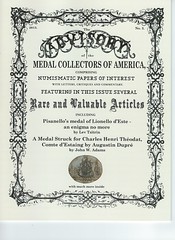 The latest edition of the MCA Advisory landed in my mailbox today, and, as
usual, all other activity immediately ceased. The cover by Neil Musante is worthy of an award itself, and the content only gets better.
Among other enticements, John Kraljevich nearly gets fooled by a George III Indian Peace Medal, while John Adams delivers original
research based on the recent Dupré hoard sold by Bonham’s. This issue concludes with an important announcement from Dick Johnson
announcing his medalartists.com website.
The latest edition of the MCA Advisory landed in my mailbox today, and, as
usual, all other activity immediately ceased. The cover by Neil Musante is worthy of an award itself, and the content only gets better.
Among other enticements, John Kraljevich nearly gets fooled by a George III Indian Peace Medal, while John Adams delivers original
research based on the recent Dupré hoard sold by Bonham’s. This issue concludes with an important announcement from Dick Johnson
announcing his medalartists.com website.
I highly recommend the print version of the Advisory, the quality of the physical production is more than sufficient to merit the additional cost. Subscription inquiries may be sent to Anne Bentley at abentley@masshist.org.
For more information on Medal Collectors of America (MCA), see:
www.medalcollectors.org
ERRORS ON MEDALS
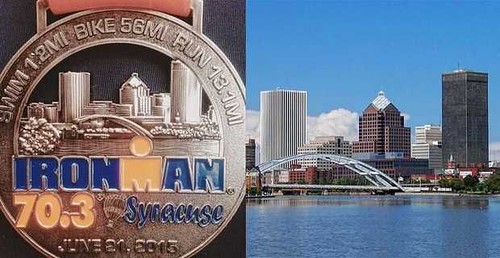
MEDAL EDITOR NEEDED
Somebody goofed at this medal maker. They struck 1,500 medals with an incorrect skyline on the obverse for an Ironman sports event in Syracuse, New York. Repeat, I said Syracuse..
After the medals were awarded to the athletes they learned the skyline was not that of Syracuse. It was the skyline of Rochester. The medal maker in North Attleboro, Mass, agreed to strike 1,500 new medals with the correct skyline.
It is easy to make an error on medals Usually it is lettering. Pictorial elements are often more difficult. Any person shown has to be the correct portrait Clothing has to be of the correct period.. Any scene has to be congruous. You can't show an airplane above a 19th century scene. So many things can be shown in error it is necessary for the designer or artist to do his homework, to research his subject
As a medal researcher I have learned of many of these errors. It required its own category -- Errors On Medals.
When I archived Medallic Art Company medals I learned they were not without fault.. But their record was astounding! Of over 6,000 medals I cataloged. I found only three medals with major errors. Two were man made, and one was mechanical -- a broken tracing point on the Janvier machine.
This was to the credit of our medal editor, no less than a vice president, Julius Lauth. Not only did he issue commissions to artists, he demanded that they furnish the source of any questionable pictorial element. He would examine every inch of a model a sculptor would submit. It had to have correct lettering and be perfect in every element. Two letters transposed in a legend once, and a name misspelled once. Pretty good odds.
To read the complete articles, see:
Syracuse Ironman event hands out
medals featuring wrong city (http://nypost.com/2015/06/23/syracuse-ironman-event-hands-out-medals-featuring-wrong-city/)
Oopsy Syracuse
Ironman Medals Display Rochesters Skyline (www.syracuse.com/news/index.ssf/2015/06/oopsy_syracuse_ironman
_medals_display_rochesters_skyline.html)
WORKING WITH FREY'S DICTIONARY OF NUMISMATIC NAMES
Do you know if this reference exists digitally as an easy to use source?
A DICTIONARY OF NUMISMATIC NAMES THEIR OFFICIAL AND POPULAR DESIGNATIONS
ALBERT R. FREY
THE AMERICAN NUMlSMATIC SOCIETY
NEW YORK 1917
I found it on line as a PDF, and downloaded it into MS Word, but now what I have is a 146-page paragraph. Yes, it is all there, in one long stream of text. So I have to put in hard returns to open up to each listing word. I will do the work needed if it does not exist in a orderly form, but I would rather not waste several hours if there is no need to.
I am not sure if a 1917 work is going to be more helpful than newer studies or full of more errors, but it is worth a look. So – Shall I get to work on everyone’s behalf or does someone have this book in a handy form?
Dick Johnson writes:
I am very familiar with Frey's dictionary. As a teenager 60 years ago I purchased two copies, cut out each entry and pasted them on color-coded cards. I learned Frey is overloaded with coin names and denominations. I was more interested in the scientific terms in the numismatic field.
When I retired I had time to write the book I had in mind. It became my Encyclopedia of Coin and Medal Technology.
I made a study of the existing numismatic dictionaries in all languages, plus some of the better glossaries.
I doubt Frey is available digitally. I have long since advanced from Frey to other dictionaries. I selected only terms of universal use in numismatics (not denominations and coin names of limited scope).
If you understand German, I recommend Schroder, Worterbuch de Munzenkunde. {1930}
Mentioning Frey brings back a flood of memories. I remember that color code for Frey's terms; pink cards for coin denominations, blue for coin names, green for paper money terms, white for economic terms, odd and curious, miscellaneous, and salmon color for technical terms. It was the salmon terms that held the most interest for me.
In my sophomore year in college I took a course in philosophy, the professor instilled in me an interest in words and their meanings. After that year I thought I would never go on to college, so I planned to teach myself. I wanted to learn numismatic terms so I bought the most expensive Webster's Dictionary. It was leather bound and had a history section in the back. I loved that book. I poured over it for hours, copying terms and entered these on my color cards. That dictionary is still in my library -- now with broken spine and dog-eared pages.
After four years in the military service I was able to go back to college, Washington University in St. Louis. I had an apartment off campus and filled it with numismatic books, and that file of colored cards. Eric Newman visited me several times in that apartment (he lived on one side of Washington U campus, I lived on the other). We talked for hours about numismatics and the books on my library shelves. And also that card file of terms.
Years after college I moved from one job to the next. I never lost interest in numismatic terms, however (but did dispose of that card file along the way). In retirement I gathered all those terms again and wrote Encyclopedia of Coin and Medal Terms.
THE BOOK BAZARRE
ARTICLE PROFILES PARKWAY QUARTER DESIGNER FRANK MORRIS
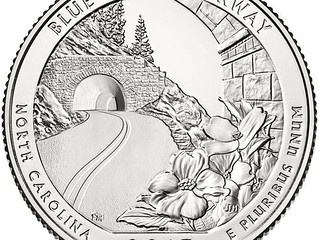 Even though he's a big-time artist with gigs for the U.S. Mint, designing commemorative U.S.
Marshall's coins and Congressional Medals of Honor, there's still something that makes Frank Morris feel like a little kid
again.
Even though he's a big-time artist with gigs for the U.S. Mint, designing commemorative U.S.
Marshall's coins and Congressional Medals of Honor, there's still something that makes Frank Morris feel like a little kid
again.
That would be riding through the tunnels on the Blue Ridge Parkway.
Fitting then that Morris, an artist, designer and illustrator who lives in Memphis, Tennessee, was chosen by the U.S. Mint to create the design for the new Blue Ridge Parkway America the Beautiful Quarter, which will be unveiled in a Parkway Quarter Launch and Coin Exchange Thursday in downtown's Pack Square Park.
Festivities at the Quarter Launch will include music by Grammy winner David Holt, Blue Ridge Parkway rangers, who will have park activities for children, and every child in attendance younger than 18 will receive a free quarter and U.S. Mint coin box, said Leesa Brandon, parkway spokeswoman. Also attending will be Lt. Gov. Dan Forest, David Croft, associate director of manufacturing for U.S. Mint, and Parkway Superintendent Mark Woods.
Morris' design, which was engraved by Joseph Menna, depicts the image of leaving one parkway tunnel as you enter another, along the graceful curvature of the parkway hugging a mountainside, and framed by the state flower, the dogwood.
"When the assignment came up, I was delighted because I had just traveled the entire parkway," Morris said. "I had the pleasure of driving from New York City down to D.C. and Shenandoah National Park and took the Parkway from there."
Morris said 80 percent of designing a new coin is research and brainstorming, because all designs must be historically and architecturally accurate. He came up with 18-20 sketches of different parkway landscapes, one including the Linn Cove Viaduct, which skirts Grandfather Mountain.
But in the end, the tunnels had it.
"As an artist, I appreciate the skill that went in to creating the stone tunnels. Italian and Spanish immigrant stone masons built them. Tunnels bring out the kid in me. I felt connected to them — the intelligent design, the experience of it all."
Morris said his design does not exactly depict any one tunnel on the parkway, but is meant to evoke the general memory of the experience of driving the parkway.
"The biggest challenge is trying to create a really big impact on a tiny quarter. I spend a lot of time designing a theme —to evoke that feeling of coming out of one tunnel and heading into another. It is a collective memory of the tunnels. So many people in so many states move through that environment — the dogwood, two tunnels, coming out of one and going into another. Overlapping that stone section is a way to show the scale. You have to whittle it down to its essence.
"I love that people can look at this coin and remember their experience on the parkway, or it will encourage them to come visit the parkway."
To read the complete article, see:
Parkway
quarter designer inspired by tunnel artistry
(www.citizen-times.com/story/news/local/2015/06/23/parkway-quarter-designer-inspired-tunnel-artistry/29175867/)
THE BLUE RIDGE QUARTER LAUNCH CEREMONY
U.S. Mint Public Affairs Specialist Lateefah Simms wrote on Thursday:
The United States Mint held the ceremonial launch of the Blue Ridge Parkway quarter today, June 25, at 10am at the Pack Square Park in Asheville, NC. We had a very successful event, with approximately 750 people in attendance (including 150 children). Asheville Savings Bank exchanged $24,000 in quarters after the event.
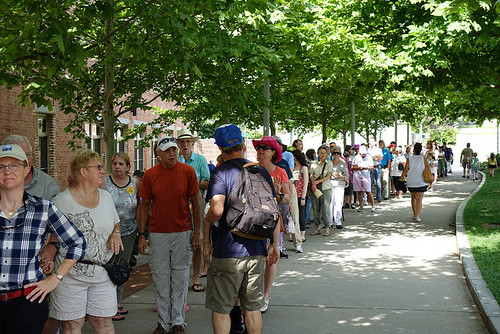
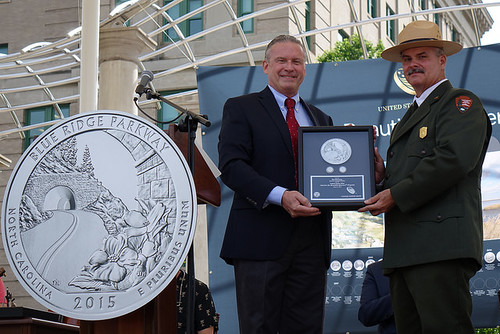
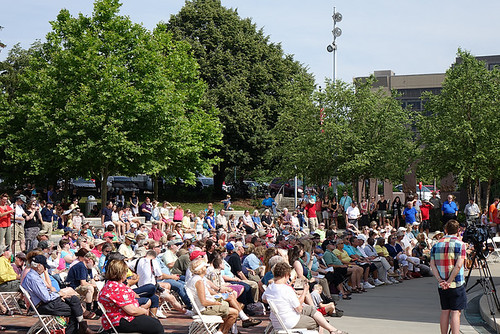
To view the complete set of event photos, see:
https://www.flickr.com/photos/129211989@N07/sets/72157655001373246
QUICK QUIZ: WHAT DO THESE PHOTOS HAVE IN COMMON?
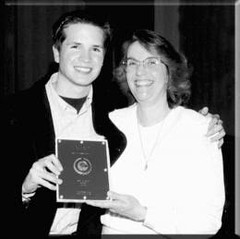
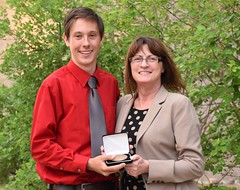
THE BOOK BAZARRE
THE 'KEEP HAMILTON' MOVEMENT GAINS STEAM
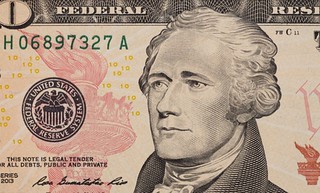 The $10 bill announcement by Treasury Secretary Jack Lew last week was intended to set off both a
celebration and a great national debate: For the first time in more than a century, the portrait of a woman would grace a major
denomination of U.S. paper currency, and the government wanted the public to help decide which heroine of democracy would receive the
honor. The redesigned sawbuck would be unveiled in 2020, in time for the centennial anniversary of women’s suffrage.
The $10 bill announcement by Treasury Secretary Jack Lew last week was intended to set off both a
celebration and a great national debate: For the first time in more than a century, the portrait of a woman would grace a major
denomination of U.S. paper currency, and the government wanted the public to help decide which heroine of democracy would receive the
honor. The redesigned sawbuck would be unveiled in 2020, in time for the centennial anniversary of women’s suffrage.
The Treasury Department got its debate all right, but not the one it was looking for.
Instead of weighing the merits of America’s most iconic women, some of the nation’s most prominent voices have been fighting to save the founding father she would displace: Alexander Hamilton. Chief among them was Ben Bernanke, who as chairman of the Federal Reserve oversaw the central bank responsible for issuing the nation’s currency. “I must admit I was appalled to hear of Treasury Secretary Jack Lew's decision last week to demote Alexander Hamilton from his featured position on the ten dollar bill,” the typically-circumspect ex-chairman wrote on the blog he publishes for the Brookings Institution.
In a piece devoted to the exaltation of the country’s first Treasury secretary, Bernanke added that placing a woman on a currency note was “a fine idea, but it shouldn't come at Hamilton's expense.” On the White House’s “We the People” website, two separate petitions have been launched to keep Hamilton on the $10 bill.
The controversy stems from the messy convergence of a grassroots movement and a federal bureaucracy moving at its ordinary, glacial pace. For months, a campaign called Women on 20s has been gaining steam in its bid to pressure the Treasury Department into replacing Andrew Jackson on the $20 bill with a woman in time for the 2020 commemoration of the 19th Amendment guaranteeing women the right to vote. This spring, the organization boasted that more than a million people had voted in an online tournament it held to nominate a woman for the $20. (Harriet Tubman was the winner.) And Senator Jeanne Shaheen of New Hampshire introduced legislation to mandate that a woman be placed on the note.
Aside from the significance of the number twenty, activists had targeted Jackson because he is easily the most objectionable of the men now featured on the major currency notes. (George Washington, Abraham Lincoln, Ulysses S. Grant, and Hamilton round out the cast. The slave-holding Thomas Jefferson was no saint, but who actually uses $2 bills?)
Yet while the Women on 20s push had gained momentum recently, the Treasury Department’s currency redesign process has been years in the making. And the note next slated for a new look was the $10 bill, not the $20. The driving factor behind any change in the currency is always technological rather than aesthetic—the Treasury Department needs to update each note every so often to stay ahead of counterfeiters, and according to the department, security officials in 2013 recommended that the $10 be prioritized “assuming no other counterfeit threats emerge.” In his public remarks, Lew has stressed that the decision was not meant as a snub of Hamilton, a man he hailed for laying “the groundwork for our economy and America’s longterm prosperity.” He promised that Hamilton wouldn’t be kicked off the sawbuck entirely; keeping two distinct designs is one option, or he could be featured in a smaller way or on the back of the note.
For the advocates of putting a woman on the $20 bill, Treasury’s announcement has made a jubilant moment considerably more awkward. “This is quite the conundrum,” Barbara Ortiz Howard, the founder of Women on 20s, told me. “This was originally supposed to be a celebration of women and their contributions to this country, and a great byproduct was going to be replacing someone who represents hate. And now we have a bit of a curveball.”
To read the complete article, see:
Decision to Put a Woman on
the $10 Bill Sparks Unexpected Backlash
(www.govexec.com/oversight/2015/06/decision-put-woman-10-bill-sparks-unexpected-backlash/116164/)
To read the earlier E-Sylum articles, see:
A WOMAN'S PORTRAIT PLANNED FOR U.S. $10 BILL
(www.coinbooks.org/esylum_v18n25a11.html)
SEVERAL WOMEN TOUTED FOR $10 BILL
(www.coinbooks.org/esylum_v18n25a12.html)

NUMISMATOURIST HOWARD BERLIN VISITS MADRID
This trip was a bit different most of my previous ones – my wife would be joining me and we would be celebrating our 40th wedding anniversary at the trip’s end. Our trip would cover Madrid plus a number of cities down to the Costa del Sol and Gibraltar, and then a few days in London to include a day trip to Oxford.
Our first stop was Madrid, a city I had been to several times. Besides, tapas and other culinary specialties, it has three numismatic venues, which for various reasons, I was not able to visit two of them on my previous visits – only seeing the buildings from the street. This time would be different, making appointments with the museums.
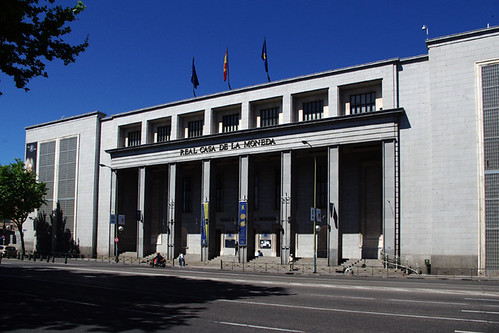
Street view of Madrid’s Royal Mint.
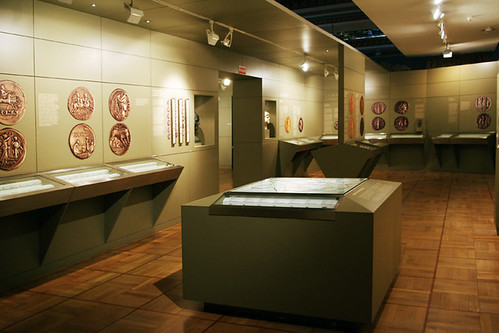
Partial view of one of the many mint museum’s many galleries.
Early Saturday morning we went to see the museum at Spain’s Royal Mint, Real Casa de Moneda. I had written Juan V. Teodoro Vidal, the museum’s director several weeks before and he was able to clear the way for my visit and allow me to take photographs. We were directed to the third floor where the permanent exhibit was located in more than 17 rooms, or halls. My only complaint to what was otherwise an excellent exhibition in its breath and scope, was that the explanatory text is only in Spanish (yo no hablo español).
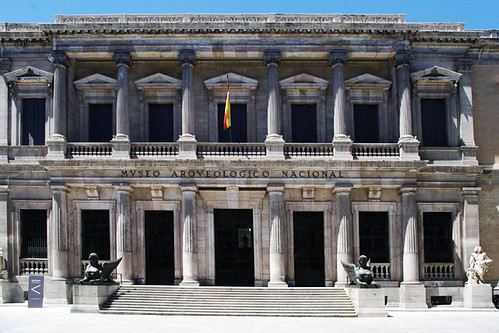
Front facade of the National Archeological Museum.
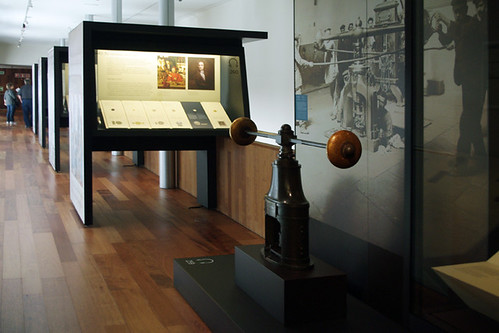
View of the National Archeological Museum’s exhibit on the mezzanine with a fly, or screw press in the foreground.
After the visiting the Royal Mint’s museum, we took the metro to National Archeological Museum. Compared with the Royal Mint, this museum’s numismatic exhibition is quite a bit smaller in its breadth but just as interesting, occupying 14 displays on one section of the mezzanine floor.
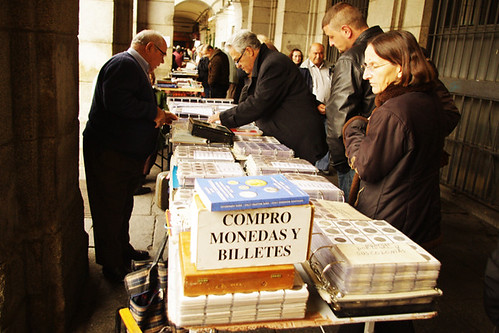
One of the many sellers at the weekly Sunday flea market under the arcades of the Plaza Mayor. The sign says “I buy coins and banknotes."
On Sundays from 9 am to 3 pm, there is an outdoor flea market of both numismatic and philatelic items held under the arcades of the Plaza Mayor – a well-known Madrid tourist spot which has an infamous past. The Plaza Mayor is an enclosed rectangular square with nine entrances that was originally built in 1619 and last reconstructed in 1790 after a series of fires. There are three stories with residential units having over 230 balconies facing the plaza above arcades that surround it. Over the centuries the plaza has been graced with the royal court, bullfights, and the Spanish Inquisition, where suspected heretics were tried and quickly executed.
Today, as it is every Sunday morning, rain or shine, many of Madrid’s coin and stamp buyers and sellers converge on the Plaza Mayor’s arcades for the weekly flea market. This is nothing fancy. Some sellers operate using a simple card table and a few notebooks filed with coins; other have more elaborate setups. Most of the items are Spanish coins, banknotes, postcards, bottle caps, and stamps, but on any given day, some dealers will have non-Spanish items, even U.S. mint and proof sets. It gives a good idea what some Spaniards collect. Like most flea markets, some haggling is encouraged.
Next: Oxford and the Ashmolean Museum
MEDALLIC REMEMBRANCES OF LONDON BRIDGE
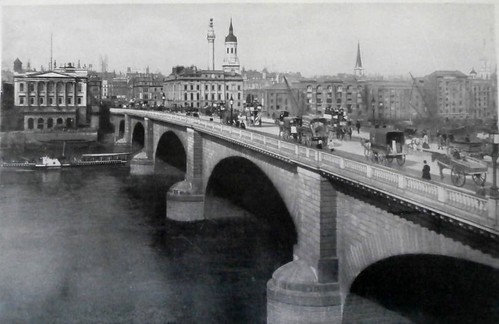
London Bridge circa 1890
London Bridge is mentioned in The Adventure of The Greek Interpreter as Holmes and Watson rush to rescue Mr. Melas from his abductors. London Bridge and the nearby London Bridge Station are also referenced in the following stories from the Canon: The Man With The Twisted Lip, The Adventure Of The Norwood Builder, The Adventure Of The Bruce Partington Plans, and The Adventure Of The Retired Colourman.
In this post, we will take a look at a few medals and tokens that feature the London Bridge that existed for the stories in the Canon.
Construction of the “new” London Bridge began in 1824 to replace the 600 year old London Bridge that desperately needed to be replaced. The foundation stone was laid on June 15, 1829 and the bridge was completed and opened for use on August 1, 1831. The bridge would continue in use until a replacement bridge was built around the now “old’ bridge starting in 1967. The “old” bridge was disassembled carefully and the stones recorded to be sold to an American entrepreneur. After the “old” bridge had been removed, the two replacement bridges had a central span build to connect the two bridges into one “new” London Bridge.
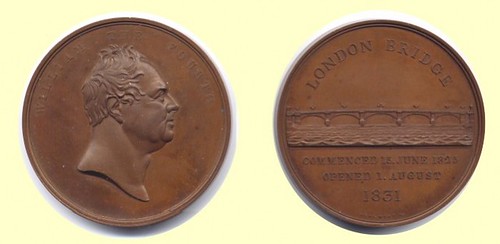
Prior to the opening of the bridge on August 1, 1831 a huge banquet was held in a tent on the bridge to celebrate. King William IV and Queen Adelaide attended the festivities. This 51mm bronze medal was engraved by Benjamin Wyon, who earlier in 1831, became Chief Engraver of the Seals by appointment of the King.
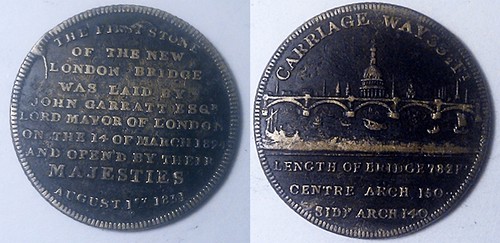
This 28mm base metal token also commemorates the opening of the bridge. This token states that the first stone of the bridge was laid March 14, 1824 and not the date of June 15, 1824, which is the generally accepted date.
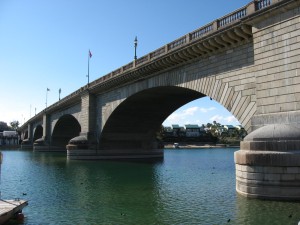
The dismantled “old” London Bridge would be packed up and sent through the Panama Canal on a journey that would take it to Lake Havasu City, Arizona. The reassembled bridge would be rededicated on October 15, 1971.
Excited to show everyone his handiwork, he began carrying it upstairs on a small table from the basement family room. He hit a bump and watched in horror as the entire bridge slid off the table and crashed to the floor, shattering it worse than a German Blitzkreig ever could. We heard his bloodcurdling scream and ran to see what happened. He scared the crap out of us. He was inconsolable, but did eventually calm down and could (almost) laugh about it. We tried not to, but it was hard. At least no one was hurt, and he'd have a chance to build it all over again a second time.
So when he started singing "London Bridge" as we rolled down the highway, I knew he was coming to terms with the incident. And planning to bubble wrap and duct tape it next time. -Editor
To read the complete article, see:
Some Medallic Remembrances of London Bridge
(http://fourthgarrideb.com/2015/06/some-medallic-remembrances-of-london-bridge/)

IMAGES SURFACE OF PURPORTED ISIS COINS
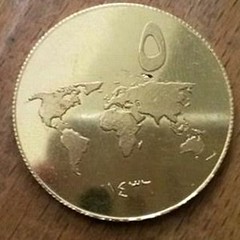 ISIS supporters have been showing off the depraved jihadi group's
latest propaganda ploy on social media - Islamic State's own currency.
ISIS supporters have been showing off the depraved jihadi group's
latest propaganda ploy on social media - Islamic State's own currency.
Several images of gold coins have been claimed as the long awaited and much talked about currency of ISIS.
One of the coins appears to have a detailed image of corn husks blowing in the wind whilst another coin has a map of the world.
The corn grains appear to be an attempt by ISIS to show how the brutal jihadist group provide for their people.
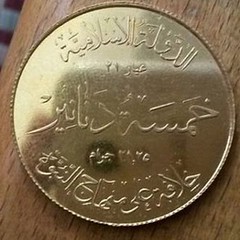
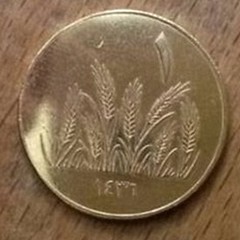
In reality, residents in Mosul, Iraq's second largest city, have complained about food shortages amid rising prices since the arrival of ISIS in June 2014.
The coin is marked with the Arabic numeral one, suggesting the coin might not be worth a great deal.
Another coin, labelled with the Arabic number five, has a map of the world and the date written neatly in Arabic.
Each of the shiny gold coins have been described as being a 'dinar', a common currency unit used in nine pre-dominantly Islamic countries.
The gold dinar appears to be an attempt by ISIS to show its commitment to honour the historic roots of Islam as gold dinars were used under the Umayyad caliphate.
Several months ago, a couple of similar images of gold coins were passed around by ISIS supporters on networking sites.
Now with Eid coming soon after Ramadan, ISIS fanboys have excitingly claimed that the currency will be used in time for Eid.
This fantasy stems from the issue that ISIS continues to churn out propaganda material in an attempt to suggest that it operates as an actual state rather than a barbarous gang.
It remains to be seen whether the coins will actually be mass produced and replace the extremist group's ever reliance in buying and selling using US dollars.
To read the complete article, see:
Is this ISIS’s currency? Terror group supporters reveal photographs of gold coins on social media
(www.dailymail.co.uk/news/article-3136312/Is-ISIS-s-currency-Terror-
group-supporters-reveal-photographs-gold-coins-social-media.html)
